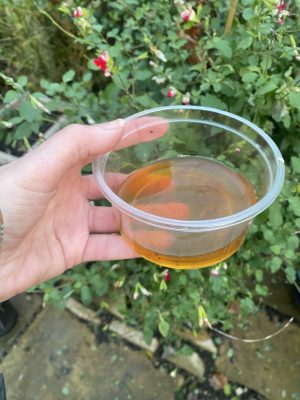I started Bokashi composting in October. It’s a Japanese method of pickling food waste, transforming the contents into nutrient-rich fertiliser to benefit plants – it’s so easy. All you need are two Bokashi bins, and specialised bran that accompanies the bins. Furthermore, the juice from solid waste can be used to clean blocked drains and reduce algae in septic taps.
Our article is for beginners and runs alongside a Bokashi playlist on YouTube. And if you like organic gardening, my worm composting playlist might be of interest, too. As with worm composting, you do not need to be an experienced gardener to start Bokashi. You can apply the Bokashi system even if you live in a flat because the bins are kept indoors. And no, you will not smell rotting food if you pickle food correctly. Bokashi composting is about contributing towards sustainable living, preventing food waste and helping your plants and garden to thrive.
“Bokashi is a new and alternative way to enhance your composting requirements. From Japanese, Bokashi can be translated to ‘well fermented organic matter’. It is seen as a useful alternative to the traditional composting method and is easy to develop yourself. Bokashi is an excellent soil improver and it will create a healthy environment for all its inhabitants. When combined with Bokashi, soil becomes healthier and crumblier, making it much easier for plants to take the root better. “
Gardening Naturally
What is Bokashi composting?

Bokashi is a Japanese method of pickling food waste in bins designed for Bokashi – you need to purchase two bins because as your packed bin ferments over two weeks, you add food to a second bin. Bins range in price and can be quite high. Ensure your chosen brand comes with Bokashi bran otherwise you’ll need to buy separately.
A Bokashi bin will consist of the main container, an airtight lid, an interior draining plate, an outside tap and a damper to compress food. My video demonstrates how easy it is to assemble.
The great thing about Bokashi is that any cooked, uncooked, leftover pet food can be put in the bin, except liquid (milk, water, juice etc). Sprinkle specialised bran over each layer of food, and compress the contents with the damper to reduce air pockets. Replace the lid, securing it tightly to prevent air from getting inside. It will minimise the risk of food rotting – the correct fermentation process must be anaerobic (without or very little air).
Bokashi bran is full of microorganisms, fermenting the bin contents and preventing the food from smelling. The bran has a distinctive scent – to me, it’s similar to vinegar.
Throughout the entire period, consistently drain off any liquid using a small Tupperware box beneath the tap.
I recommend buying a food caddy to store food scraps in because it’s best to avoid opening the Bokashi bin daily to minimise the air risk. Poundland sells kitchen caddies for £3 or The Range sells them for around £10. If doing worm composting alongside, have two caddies.
I operate both Bokashi and worm composting and because worms cannot eat some foods, I put this food into my Bokashi bin.
Recommended Bokashi bins
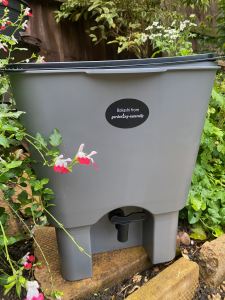
Of course, you can make your own Bokashi bin. There are plenty of DIY videos on YouTube. My two 15-litre Bokashi bins cost £39.99 and can be bought from Garden Naturally’s shop on Amazon or Esty. The price includes Bokashi 1kg bran accelerate and a scoop, too. Quite often, Etsy emails a coupon and recently I got 10% off an order.
Dimensions for my Garden Naturally Bokashi bins:
Height 37cm
Width 30cm
Depth25 cm
Again, It’s easy and quick to assemble as shown in my video below.
Watch the Video: Assembling a Bokashi bucket
How to start Bokashi composting at home
It’s easy. Decide on your price range, buy a two-bin set with Bokashi bran. If you are making your own Bokashi bin or prefer another style, I can offer you £2.50 off from Wiggly Worms using my referral link. And sometimes there are further discounts for newly subscribed customers.
You must top up your Bokashi bin every three days instead of daily to limit air contamination, and the micro-organisms will ferment the food day by day.
Food for your Bokashi bin:
- Wet pet food
- Any vegetables
- Any fruit, including seeds
- Cooked or uncooked food
- Meat
- Fish
- Bread
- Dairy
- Coffee and non-plastic bagged tea bags
- Plant material
- Any foods that are toxic for your composting worms
After sprinkling bran over a layer of food, compress the food using the damper. The damper supplied with my Bokashi bins doesn’t feel overly strong. If preferred, a potato masher or flat-based builder tool can be used. Ensure the lid is back on securely and air-tight to prevent the fermentation process from failing.
Subscribe to my Bokashi series on YouTube: The Bokashi playlist on YouTube
The bins with content must be kept indoors at room temperature. Keep filling your first bin, and when full, leave aside for two weeks but start filling the second bin.
How often do you drain the Bokashi?
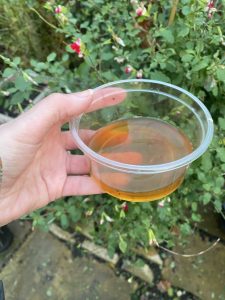
Bokashi liquid comes from fermented food scraps and needs to be drained off regularly, even when your bin is full. I drain off every few days and fill two small tubs. I then use a funnel and pour it into a bottle.
Bokashi liquid for plants –
With the help of Bokashi bran, the liquid is full of nutrients and can be used to feed plants. But it must be diluted before feeding plants – Gardening Naturally recommends mixing two teaspoons of Bokashi liquid with every litre of water. The bad news is that Bokashi liquid has to be used within one day of draining because it’s full of beneficial micro-organisms, and if unused, it will start smelling.
Another use is diluted liquid in your outdoor compost bin using those micro-organisms.
Bokashi liquid for cleaning –
The wonderful thing about Bokashi organic liquid is its ability to clean drains, pipework, toilet bowl, and anti-algae for septic tanks. And can be used undiluted. It’s November and I’ve poured it down two sinks already – the juice can also stop the grease build-up.
Pipework can become blocked as plant roots seek water and grow through cracks. The Bokashi liquid is acidic in its concentrated form, so it will stop plants from living. Equally, those little microbes in the liquid will clean pipes and muck.
The benefits of Bokashi and its fermented food
“Absolutely no smell from these. Not only does your food waste break down really quickly you also get a good amount of liquid fertilizer from them. SO much so that I have shared mime with neighbours.”
Debby – customer of Gardening Naturally
I love doing Bokashi because it contributes towards green living and gives me organic fertiliser for the garden instead of horrid chemical feeds.
If you prefer organic products, you might be interested in my article Eco Hacks to Create a Sustainable, Healthier Environment for You & Your Pets – it contains useful eco-friendly homemade products for you and your pets, including a urine stain remover and pet-safe home flea killer.
The outcome of a Bokashi bin is nutrients for both garden and plants from food waste and liquid. The liquid is also helpful as a drain or sink unblocker or for septic tanks. I’ve already poured two tubs into the sink and even though the liquid is from food waste, it does not smell.
The Bokashi method is not limited to homeowners with gardens and can be used by flat-owners who want green living. Bokashi liquid can fertilise indoor or balcony plants and the fermented food can be donated elsewhere.
Bokashi bins are small and easy to store, and when the first bin is complete, the empty bin can be placed on top.
If you like the concept of recycling food waste, even teaching the children about sustainable living, and are too squeamish for worm composting then the Bokashi method is for you.
Beginners Bokashi composting tips
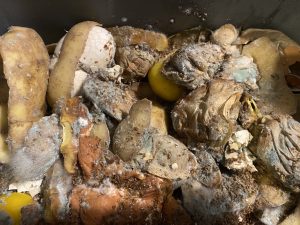
When we start something new, we learn from errors and can avoid making the same mistakes in the future, hence publishing a beginner’s guide for starting Bokashi.
Food has dark mould – if contents change to a dark colour and consistently cover a vast area of your bin, there’s too much air contamination, and the fermentation process has failed. You may have opened the bin too often or not compressed food waste enough. Another reason is not enough Bokashi bran has been added. If dark mould is extreme, empty and discard the contents, wash the bin with water, dry it, and start again with new food waste.
If you spot a small area of dark mould, you can attempt to salvage the contents by adding more bran. But if dark mould accumulates, then start again.
The lid is not securely on the bin – we’ve mentioned above about air contamination. If too much air enters your bin, the microorganisms will stop working. Put the lid on tightly.
Not draining the liquid or often enough – the liquid comes from fresh food scraps and eventually, the Bokashi juice collection tray will fill up. If the liquid exceeds the drainage tray, food scraps will be submerged in liquid. Your Bokashi bin will develop problems and possibly start smelling so it is vital to drain regularly.
The bin smells of rotting food – if it smells of anything other than vinegary from the bran, then the contents are contaminated and it’s advisable to start again.
Adding mouldy food to the bin – Yes, you can add food that has mould but overall, it is unhealthy for you because of spores.
Cleaning the bin – Cleaning the bin can be done indoors or outdoors. Pull the bin apart, even the tap and wash down thoroughly with water
White colour on food waste – this is excellent! Your Bokashi contents should have white fluffy mould growing on it. You are successfully doing Bokashi!
What do I do when the Bokashi bin is full?
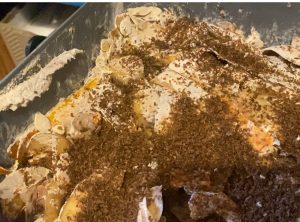
Leave your full Bokashi bin sealed and aside for two weeks but continue draining off the liquid. During this time the fermentation process will continue. The food volume will decrease and any water content from food scraps will go into the juice collection tray.
How do you use fermented Bokashi food?
After the full Bokashi bin has completed its indoor fermentation process, you have pre-compost. Before using Bokashi as fertiliser, the contents must be broken down more.
When my first bin has finished its two-week fermentation process, I’ll mix the pre-compost into the natural materials in my compost bin.
I’ve upcycled two indoor recycling bins I purchased from Wilko and made those into outdoor compost bins. I drilled holes in the base for drainage and for earthworms to crawl in. The bins are light, so initially, I need a brick inside to weigh it down. The second bin has natural material inside. Both bins stand in a sheltered corner of the garden and the top is covered by a lid and shed felting (and secured with a small slab) to prevent rain from getting in. In the future, I’ll invest in a proper composting bin.
Subscribe to my YouTube channel so you don’t miss the next video.
If you live in a flat, you can give your Boskahi to someone with a garden and they can continue the decomposition process buried in the ground.
You’ll find many videos on YouTube showing how fermented Bokashi food can be buried in raised beds and gardens. The pre-compost will initially be too acidic to feed plants or mix into soil. Give the Bokashi two to three weeks to decompose fully. Choose an area in your garden without plants, dig a hole or trench about 20cm deep, and tip in the Bokashi. Cover with soil for the set period. If wet weather, cover with waterproof tarpaulin and secure with bricks or broken slab pieces.
Whichever method you choose, following the decomposing period, you’ll have nutrient-filled top soil.
Some Bokashi experts recommend using the Bokashi contents in a worm bin after the buried decomposition period. First, allowing the food to decompose fully is essential as feeding composting worms with too much acid can kill them. Secondly, if you include food that are toxic to compost worms (the onion family, for example), this food is harmful and can kill worms. My choice is to run the worm composting and Bokashi independently of one another. My article about Starting a Worm Bin can guide you through the worm composting process.
Watch the The Worm Gang series on YouTube
Bokashi vs. worm composting
Explore the key differences between Bokashi and worm composting methods.
| Bokashi – pros | Worm Bin – pros | Bokashi -cons | Worm Bin – cons |
|---|---|---|---|
| Sustainable living | Sustainable living | Liquid can smell if undrained | You need to handle the worms |
| Compost all food types | Liquid feed for plants | Drained liquid can smell if unused | Worm bins can be expensive |
| Small containers | Worms castings soil conditioner | Liquid must be used within a day. | Some foods are toxic |
| Liquid can be used as a cleaner | Education for the kids | ||
| Liquid & decomposed scraps can be used as a ferliser | Liquid does not smell and can be stored | ||
| No worms involved | Add 50% carbon material | ||
| Education for the kids | Can be stored outside |
Key takeaways:
- Decreasing food wastage and being green
- My recommended bins are under £40
- You can add any food to your Bokashi bin
- The kids can take part and learn about eco-living
- Bokashi liquid will keep drains healthy
- You can Bokashi living in a flat
- You cannot add liquids (milk, juice etc)
- It’s easy!
Proud owner of bokashi bins and The Worm Gang for worm composting!

